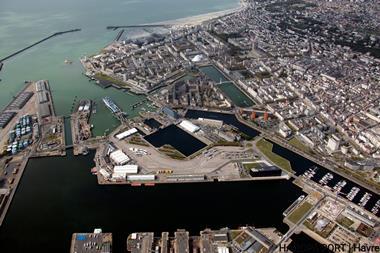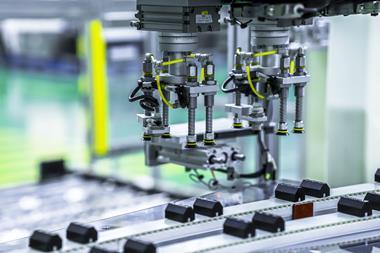
Already integral to European vehicle production, Turkey is back on track to becoming a base for automotive output on a global scale, but OEMs operating there need to tackle the risks involved in their disparate and over-extended supply chains
Turkey’s automotive sector has been a big part of the economic progress the country has made over the past decade. Attracted by its combination of proximity to Western European markets and a young workforce, the automotive sector has turned Turkey into a production platform, first for Europe and now for the world.
Total output of passenger cars and commercial vehicles in Turkey increased more than 27% to 893,119 units in the January-October period of 2010. There are 12 vehicle manufacturers in the country but it is Renault and Ford that are in the vanguard. Renault has a joint venture with Oyak, which is an investor linked to the influential Turkish military. Opened in 1969, the assembly complex at Bursa is very large with a production in 2009 of 300,000 vehicles, principally the Clio and the Mégane, but with some Basic production as well.
The other big operation is Ford at Istanbul. Ford Otosan is a joint venture between Ford and the Turkish company Koç holdings, Koç being a key company in the Turkish automotive sector, having joint ventures with Fiat as well as its own production facilities. Grown out of a local CKD facility, the Kocaeli plant just outside Turkey’s capital is now the largest producer of Ford Transit light commercial vehicles, supplanting its British assembly plant in Southampton as the lead site for this key product. Part of the same complex is the Ínönü plant, which produces both engines and larger Ford Cargo trucks.
Besides these two leaders are a clutch of manufacturers, both Turkish and global carmakers. Toyota and Hyundai both have their own plants but Fiat, which is the third largest producer in Turkey, has a large joint venture with the Turkish group Tofas. There are also truck plants owned by Daimler and Mitsubishi.
From the late 1990s the Turkish automotive sector became integral to the wider European automotive industry. From this time on assembly operations grew, yet the supply chain has not yet caught up. Indeed, Turkey’s supply base reflects how integrated the country is within the European automotive industry. Ford Otosan is perhaps the best example of this, with its supply chain drawing upon the engine and other component plants of the older Ford of Europe assembly locations.
 Cengiz Kabatepe, executive vice president of purchasing at Ford Otosan, says that around 60% of components are imported into Turkey, which is not that unusual for Turkish manufacturers, generally. Some of the passenger car manufacturers have slightly higher proportions of Turkish sourced components, but all have quite different supply chain geographies than, for example, plants in Germany.
Cengiz Kabatepe, executive vice president of purchasing at Ford Otosan, says that around 60% of components are imported into Turkey, which is not that unusual for Turkish manufacturers, generally. Some of the passenger car manufacturers have slightly higher proportions of Turkish sourced components, but all have quite different supply chain geographies than, for example, plants in Germany.
For Transit production, major parts, including the drivetrain, are imported from Spain, Germany and the UK. Although the light commercial vehicles such as the Transit are produced in a different scheduling environment to that of passenger vehicles, inevitably the greater distances between the assembly plant and the supplier have an effect, increasing the risk and thus the level of inbound inventory. Consequently, logistics management is of heightened importance in the running of Turkish automotive assembly plants.
The Ford Otosan plant is also a good example of the effect on transport for such geographically extended supply chains. In an unusual move Ford stretched its existing Spain-to- Germany rail provision to serve its Turkish facility. Operated by Omfesa Logistics, a joint venture between Turkish logistics service provider Omsan and the Deutsche Bahn owned Transfesa, the service links the Ford Cologne plant with Kocaeli, but also interfaces with Fords facilities in Spain and Britain where Transfesa is also a key logistics service provider.
Kabatepe says that rail passing through so many national borders can have its difficulties, as it does crossing the Bosphorus and beyond Istanbul. However, the main obstacle for greater use of rail is the condition of the infrastructure within the country. Kabatepe observes that “there are big projects focused on the improvement of rail links between cities in Turkey but these have some way to go”.
 Sea transport for inbound components could have potential as Turkey straddles some important container shipping routes, yet again here the issue of reliability is salient. As Kabatepe comments “we cannot create extra inventory to cope with the risk of sea carriage”.
Sea transport for inbound components could have potential as Turkey straddles some important container shipping routes, yet again here the issue of reliability is salient. As Kabatepe comments “we cannot create extra inventory to cope with the risk of sea carriage”.
Consequently it is road transport that is the principal means of transport within Turkey. This not a huge problem as the road infrastructure is good and there is a strong supply of local trucking companies capable of both efficient and costeffective operations. Only at certain choke points, notably over the Bosporus, is congestion a significant problem. It dominates internal movements, whether for assembly activity, finished vehicles or aftermarket as well as being the default choice for bringing components into Turkey.
The extended nature of supply chains also has an impact on other types of logistics services. Many components have to move across a number of national borders, which makes forwarding operations more complex and increases the need for consolidation centres and other inventory management capabilities. This gives the larger global LSPs an advantage over their Turkish competitors. Aslan Uzun, managing director, Turkey and the Balkans for Ceva points out that, “When the parts are on the way for Germany, let’s say, they are moving through four or five different countries and every country has different rules and this can make things more complicated.”
The inventory environment in Turkey tends to be more complex than normal, with a mix of tight just-in-time operations between suppliers located within Turkey and higher buffer-stock conditions for the components from more distant locations, which can be quite demanding operationally. Indeed, Kabatepe asserts that “supply chain management is one of the main capacity and cost issues in the Turkish Industry”.
Baris Melek Dogan, supply chain manager at Avon Automotive agrees: “Logistics is very important for the Turkish industry as we must still import so many components as well as export. This makes management much more difficult and demands more work, more flexibility. It is different to older more established plants in other places in Europe where the patterns of working are more fixed.”
This supply chain is similarly long in terms of finished product. Roughly two thirds of production from Turkey is exported, generally but not exclusively to Western
European markets. This traffic is overwhelmingly sea-borne. Of course, the potential for overland exports and movement within Turkey exists, however, the industry has failed to grasp the opportunity that rail offers. “I have yet to see cars being moved by rail within Turkey,” comments Peter Menzel, executive director at K-Line. This is all the more extraordinary when looking at a company such as Transfesa, which brings in components by rail, yet exits the country with non-automotive related container traffic. Once again it is shown that rail suffers in comparison with short-sea shipping when moving finished vehicles.
Not that the marine transport is without problems. Until recently Turkey benefited from its excellent geographical position as finished traffic for Russia used Turkish ports as transhipment hubs. Turkish ro-ro terminals in and around Istanbul in particular experienced high demand during the boom in the Russian market, resulting in a substantial level of congestion. Since 2008 additional capacity has been created, for example at the ‘AutoPort’ at Yenikoy, near Kocaeli, which is owned and operated by the Turkish LSP Arkas and the Japanese trading house Mitsui. Of course the crash in the Russian market has now relieved the pressure in the sector somewhat, yet problems still remain.
 K-Line’s Peter Menzel observes that it is not that the ports are inefficient or that the capacity of Turkish car terminals is inadequate, rather it is the connection of the rest of transport system to those terminals. “It is not a matter of investment necessarily, it is a matter of having the ability to expand the port. A lot of the ports are in the middle of the city or behind a mountain range, and this makes connections difficult.”
K-Line’s Peter Menzel observes that it is not that the ports are inefficient or that the capacity of Turkish car terminals is inadequate, rather it is the connection of the rest of transport system to those terminals. “It is not a matter of investment necessarily, it is a matter of having the ability to expand the port. A lot of the ports are in the middle of the city or behind a mountain range, and this makes connections difficult.”
Such problems have implications for producers outside Istanbul as they are reliant on road freight to move their export traffic to the Istanbul ports. It suggests that Turkey’s infrastructure remains slightly disjointed in places, placing a cost burden on operations within the country.
A surprisingly open logistics market
A major characteristic of the automotive sector in Turkey is the influence of the big, diversified Turkish corporations. Tofas, Oyak and Koç all have strength in car production through their joint venture with global vehicle manufacturers. They also have large logistics businesses, although surprisingly there appears to be little vertical integration. Rather, the logistics market is generally open and competitive with a strong presence by the global logistics service providers.
 It is worth noting that the large global LSPs tend to have a strong presence in assembly-facing operations. A good example is Ceva, which provides inbound logistics services for a number of the major vehicle manufacturers including Ford- Otosan and Fiat-Tofas. Ceva’s Uzun observes that, “there are almost too many road freight companies in Turkey and many of them converted into logistics so there are a good number of local companies for general work. But when we come to automotive work doing inbound and sequencing these are more demanding. Here the number of competitors is limited, as they are the large local companies or big multinationals. I should say the main players are not more than five or six in number.”
It is worth noting that the large global LSPs tend to have a strong presence in assembly-facing operations. A good example is Ceva, which provides inbound logistics services for a number of the major vehicle manufacturers including Ford- Otosan and Fiat-Tofas. Ceva’s Uzun observes that, “there are almost too many road freight companies in Turkey and many of them converted into logistics so there are a good number of local companies for general work. But when we come to automotive work doing inbound and sequencing these are more demanding. Here the number of competitors is limited, as they are the large local companies or big multinationals. I should say the main players are not more than five or six in number.”
However, Dogan disagrees somewhat: “The presence of so many foreign logistics providers has made Turkish companies more competitive. There is now a very good supply of companies for consolidation work although perhaps they are not as good at forwarding between markets outside Europe”.
Dogan also points out that related areas such as customs clearance has improved hugely. “This used to be a black-hole but now things are very much better,” which is essential if Turkey’s automotive supply chain is to be sustained.
What was originally established as a domestic assembly capability has evolved into a contemporary European production location of comparative importance to that of central Europe. It is on the cusp of being a location of global importance. The latter development is illustrated by Ford’s decision to use the Ford-Otosan facility to export the Transit light commercial vehicle to North America. Yet such a development only makes the logistics performance of the Turkish economy all the more important.
It is a situation that the Turkish appear acutely aware of. No longer just a platform for European production, Cengiz Kabatepe describes Turkey as being “at the intersection of globalisation”. If Turkey is going to support its ambitions for serving the new markets of the Middle East, Central Asia and beyond it needs to continue to value its logistics capabilities.























